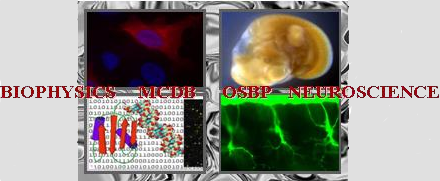Talk abstracts
Talk on Wednesday 03:45-04:00pm submitted by Eric Danhart
Induced fit binding involving a dynamic helix confers specific recognition of mischarged Ala-tRNAPro by a bacterial trans-editing domain
Eric M. Danhart (Ohio State Biochemistry Program), Lexie Kuzmishin, Marina Bakhtina, Brianne Sanford (Department of Chemistry and Biochemistry, The Ohio State University), Marija Kosutic, Ronald L. Micura (Institute of Organic Chemistry and Center for Molecular Biosciences, Innsbruck CMBI Leopold Franzens University, Innsbruck, Austria), Karin Musier-Forsyth, Mark P. Foster (Department of Chemistry and Biochemistry, The Ohio State University)
Abstract:
Aminoacyl-tRNA synthetases catalyze the attachment of specific amino acids to cognate tRNAs. Mistakes in this process lead to errors in protein synthesis that can be deleterious or beneficial to cells. Prolyl-tRNA synthetase (ProRS) mischarges tRNAPro with Ala; this aberrant product is hydrolyzed by a cis-editing domain (INS) in most bacteria. Some bacteria that lack the INS domain encode a homologous free-standing trans-editing protein known as ProXp-ala that performs the same function. ProXp-ala displays acceptor stem specificity for tRNAPro, but how it discriminates between Pro-tRNAPro and Ala-tRNAPro is less clear. To establish the structural basis for this discrimination, NMR mapping studies were carried out with an uncharged microhelixPro substrate and with a non-hydrolyzable, amide-linked Ala-microhelixPro substrate analog. Chemical shift perturbations (CSPs) induced by each RNA allowed us to identify candidate residues of ProXp-ala involved in recognition of the Ala moiety. The largest CSPs were mapped to regions of the protein that surround a large electropositive area. 15N NMR relaxation experiments revealed a mobile α-helix (α2) that exhibits significant dynamics at the ps-ns timescale, which are attenuated in the presence of mischarged RNA. Deacylation assays showed only minor effect of mutating residues in helix α2 on activity, and computational studies support the conclusion that the dynamics are significantly attenuated only in the presence of the non-cognate aminoacyl-RNA moiety. Conserved residues proximal to helix α2 in 3D space that have significant effects on deacylation rates with little impact on RNA binding were also identified. Taken together, these results allow us to propose a mechanism for substrate recognition by ProXp-ala that involves Ala-specific induced-fit binding via a mobile helix.
Keywords: NMR, tRNA, Protein-RNA interaction
